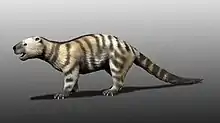| Patriofelis Temporal range: Early to Middle Eocene | |
|---|---|
 | |
| Patriofelis ferox skeleton | |
 | |
| Reconstruction of Patriofelis ferox | |
| Scientific classification | |
| Domain: | Eukaryota |
| Kingdom: | Animalia |
| Phylum: | Chordata |
| Class: | Mammalia |
| Order: | †Oxyaenodonta |
| Family: | †Oxyaenidae |
| Subfamily: | †Oxyaeninae |
| Genus: | †Patriofelis Leidy, 1872 |
| Type species | |
| †Patriofelis ulta Leidy, 1870 | |
| Species | |
| Synonyms[3] | |
|
synonyms of genus:
synonyms of species:
| |
Patriofelis ("father of cats") is an extinct genus of large, cat-like predatory placental mammals from extinct subfamily Oxyaeninae within extinct family Oxyaenidae, that lived in North America from the early to middle Eocene. It was around 1.2 to 1.8 metres (3.9 to 5.9 ft) long, not including the tail, and weighed about 40–90 kg, making it around the same size as a modern cougar. It had short legs with broad feet, suggesting that it may have been a poor runner, but a quite good swimmer. As its close relative Oxyaena was a reasonably good climber, it is possible Patriofelis could climb as well.[8] It is found in particular in the Bridger Basin of southwestern Wyoming and at John Day Fossil Beds National Monument, Oregon, both in the United States.
Gallery
 Restoration of Patriofelis ferox by Charles R. Knight |
 Skull of Patriofelis ulta |
References
- ↑ O. C. Marsh. (1872.) "Preliminary description of new Tertiary mammals. Part II." American Journal of Science 4(21):202-224
- ↑ J. Leidy, (1870.) Untitled [Patriofelis ulta proposed during Proceedings of the March 8 meeting of the Academy of Natural Sciences], in Proceedings Proceedings of the Academy of Natural Sciences of Philadelphia, Volume 22, p. 9-11.
- ↑ J. Alroy. (2002.) "Synonymies and reidentifications of North American fossil mammals."
- ↑ J. L. Wortman. (1901.) "Studies of Eocene Mammalia in the Marsh Collection, Peabody Museum." The American Journal of Science, series 4 12:193-206
- ↑ O. C. Marsh. (1872.) "Note on a new genus of carnivores from the Tertiary of Wyoming." The American Journal of Science and Arts, series 3 4(19-24):406
- ↑ W. D. Matthew. (1909.) "The Carnivora and Insectivora of the Bridger Basin, middle Eocene." Memoirs of the American Museum of Natural History 9:289-567
- ↑ R. H. Denison. (1937.) "The broad-skulled Pseudocreodi." Annals of the New York Academy of Sciences 37:163-257
- ↑ Neal Robbins (2006.) "Paleontology Discussions, Patriofelis - A Creodont"